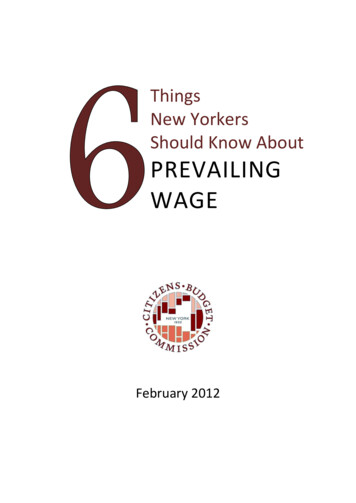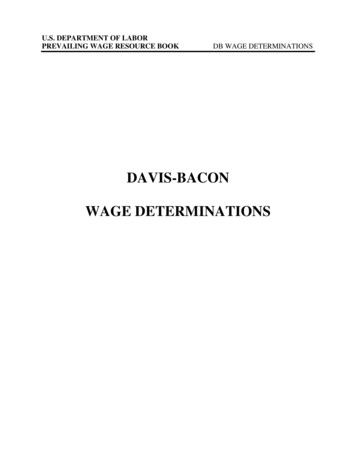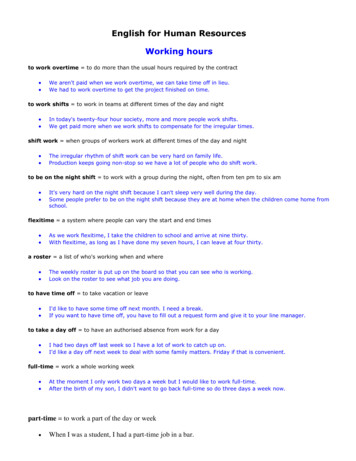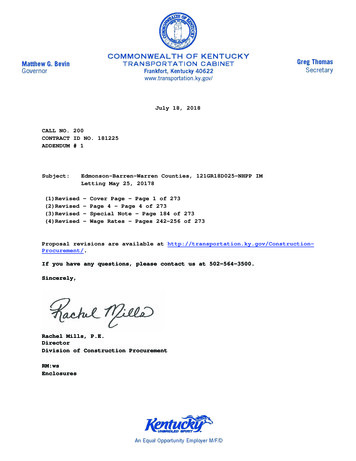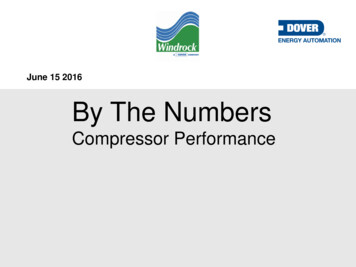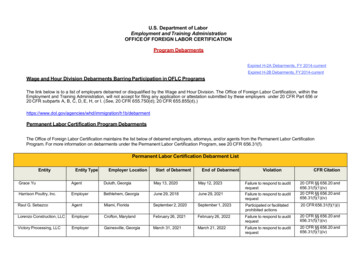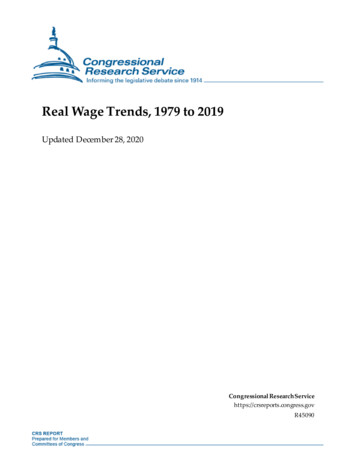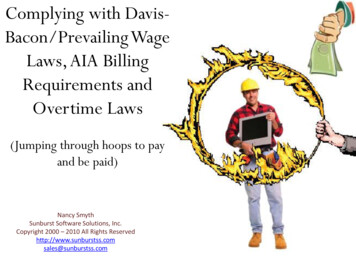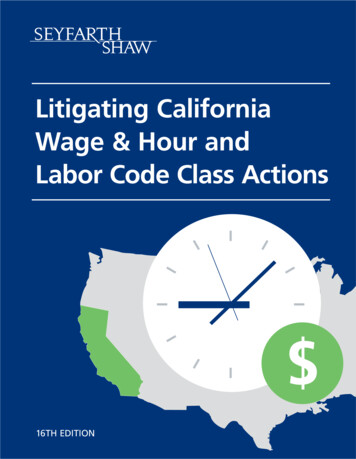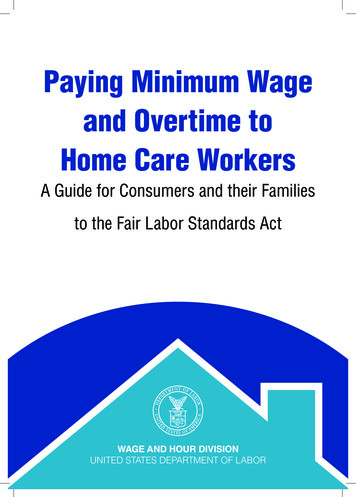
Transcription
Paying Minimum Wageand Overtime toHome Care WorkersA Guide for Consumers and their Familiesto the Fair Labor Standards ActWAGE AND HOUR DIVISIONUNITED STATES DEPARTMENT OF LABOR
Table of ContentsThis guide is meant to help individuals, families, and householdsthat use home care services determine their responsibilities under theFair Labor Standards Act (FLSA), the federal minimum wage andovertime law that applies to most home care workers.Introduction Whoneeds this guide. 4 Overview. 8Who needs to follow the FLSA rules Whenyou must pay minimum wage and overtime.12 Exemptionfrom minimum wage and overtime rules.19 Employment Live-inof family members as home care workers.22home care workers.24How to follow the FLSA rules Minimumwage.30 Overtimepay.32 Hoursworked.35 Recordkeeping.36 Consequencesof not complying with the FLSA. 39Other resources Checklistsfor paying home care workers properly.42 Additionalinformation.44
Introduction
Who needs this guide?YOUWhen we refer to “you” in this guide, we mean a consumer who usesthe services of a home care worker.We also mean any family member of a consumer who helps managethose services. Managing the services could include selecting theworker, setting the worker’s schedule, determining what tasks theworker should perform and when, paying for the worker’s services,etc.“You” also means any member of the consumer’s household, such asa domestic partner or other person who lives with the consumer, whohelps manage the services.We have created checklists to help you keep track of your obligations,found at the end of this guide.YOU may be a senior or a person with a disability, or a member ofthe consumer’s family or household, who directly hires a worker toprovide in-home support. Perhaps you used a registry or a websiteto find your worker, or perhaps you selected someone you alreadyknew, such as a family member.If this describes you, see the Direct Hire Checklist onpage 42.4YOU may be an individual who has a home care worker livingwith you or who arranged for a home care worker to live with afamily or household member who needs services.If this describes you, see the Live-in Direct HireChecklist on page 42.YOU may be an individual who goes to an agency to find a workerto provide in-home support for yourself or a member of your familyor household. Perhaps you pay the agency for the worker’s serviceswith private funds, or perhaps you receive public assistance, suchas through Medicaid. Perhaps the agency sends a worker whomoves into your home.If this describes you, see the Agency Checklist onpage 43.YOU may be an individual who receives (or helps a member ofyour family or household arrange) in-home personal care or otherservices through a Medicaid-funded self-directed program. Perhapsthe worker you select lives in your home.If this describes you, see the Self-Directed Checklist onpage 43.5
Who needs this guide?HOME CARE WORKERWhen this guide refers to “home care workers,” we mean workers whoprovide certain types of services in private homes.Home care services are fellowship and protection, personal care, and/or health-related services, such as assisting a consumer e feedingInjectionsOther medicallyrelated activitiesHome care services are provided in a consumer’s own home. Personalcare and/or health-related services that are provided in a group home,nursing home, residential care facility, or hospital are NOT home careservices.HobbiesGamesKeepingcompanyHome care workers are called by a number of different job titles,such as home health aide, personal care attendant, certified nursingassistant (CNA), provider, or caregiver.Home care workers may live in or live outside your home; they may befamily members, friends, or people you didn’t know before they beganproviding services; they may be paid with private funds, Medicaidfunds, or some other okingCleaningOther dailyactivities7
OverviewThis guide is about your responsibilities under the Fair LaborStandards Act (FLSA). The FLSA is the federal law that givesmost workers in the United States minimum wage and overtime payprotections. We at the U.S. Department of Labor enforce the FLSA,and we recently updated the FLSA rules about home care workers.Under the new rules, most home care workers must now be paidat least the federal minimum wage, and overtime pay. We call thischange the “Home Care Final Rule.”If you use or help manage the services of a home care worker, youmay be responsible for paying minimum wage and overtime, and forkeeping certain records regarding your home care worker(s). Thisguide will help you understand if you have those responsibilities and,if you do, how to make sure you pay your home care worker properlyunder the FLSA.Why did the Department of Laborpublish the Home Care Final Rule?The Home Care Final Rule makes sure that home care workershave the same basic wage protections as most U.S. workers,including those who perform the same jobs in nursing homes andgroup homes. Better wages for home care workers will also helpto ensure that consumers have access to high-quality care in theirhomes from a stable workforce.If you employ a home care worker, you may also have otherresponsibilities under other laws—such as IRS requirements,Medicaid regulations, or state employment laws—but this guide isNOT about those laws. This guide is only about the federal minimumwage and overtime law.89
Who needs to followthe FLSA rules
When you must pay minimumwage and overtimeSeeminimumwage andovertime:page 30Most home care workers must be paid at least the federalminimum wage and overtime. The relevant question isoften who is responsible for making sure these workersare paid according to these FLSA requirements. Whetheryou are responsible for the worker being paid federalminimum wage and overtime depends on whether you arean “employer” as defined by the FLSA.EMPLOYERSee jointemployment:page 18It is necessary to look at many facts about a worker’s job todetermine who is the worker’s employer under the FLSA.Although many facts matter, anyone who sets the worker’sschedule, tells the worker what tasks to do or when todo them, and/or can hire or fire the worker could be anemployer of that worker. This is true even if someone elseis also an employer (that is, if there’s joint employment).Knowing whether YOU are an employer is importantbecause if you are, you are responsible for making sure thatyour home care worker is paid according to the FLSA rules.Even if you are not considered an employer for otherpurposes or under other laws, such as paying taxes oraccording to Medicaid, you may still be considered anemployer under the FLSA. This is because courts havedefined who is an employer very broadly under this law.Am I an employer?If YOU hired the home care worker directly, and no agencyor other organization is involved, then you are an employer.YOU must ensure that you are following FLSA rules.If you set the worker’s schedule, tell the worker whattasks to do or when to do them, and/or can hire or fire theworker, you could be an employer under the FLSA. Thatmeans YOU must comply with the FLSA even if an agencyprovides the worker. Although those facts do not make youan employer for all legal purposes, they do mean you arean employer for purposes of the FLSA.Example: Direct hireDiana places an ad on a website offering to work as a personalcare attendant. Olivia, an individual with a disability who needspersonal care services, sees the ad and calls Diana to set up aninterview. Olivia likes Diana, so she hires her. Olivia and Dianaagree on Diana’s schedule, rate of pay, and job duties.In this example, Olivia is Diana’s employer. Olivia must followthe FLSA rules described later in this guide.Olivia12SeeDirectHirechecklist:page 42Diana13
When you must pay minimumwage and overtimeSee jointemployment:page 18Seerecordkeeping:page 36SeeAgencychecklist:page 43If YOU hired the home care worker through an agency,you are probably an employer of that worker. Under theFLSA, an employee can have more than one employer—in this case, both the agency and you. (We call this “jointemployment.”)If you and an agency jointly employ a home care worker,you may rely on the agency to pay the worker and keeprequired employment records. As an employer under theFLSA, the agency is responsible for following the FLSArules. But remember that if you are also an employer underthe FLSA, you are also personally responsible for anywages that are owed to the worker under the minimumwage and overtime law. This does not mean that the workergets paid twice—it simply means that if either responsibleparty does not pay the worker, the other “joint employer” isresponsible for paying them.Example: Joint employment with agencyJoe needs assistance with daily activities such asdressing and preparing meals so he can live on hisown. Joe calls Home Care Agency, which sends apersonal care attendant named Marcus to Joe’s home.Home Care Agency trained Marcus, sets Marcus’spay rate at 10 per hour, writes Marcus’s paychecks,and could fire Marcus. Joe decides how many hours ofservices Marcus should provide to Joe each day andtells Marcus what tasks to perform (such as when Joewants to bathe, what he wants to eat, where he wantsto go during the day, etc.).See jointemployment:page 18In this example, Home Care Agency is Marcus’semployer under the FLSA, and Joe is also Marcus’semployer under the FLSA. That means Home CareAgency and Joe are both responsible for making surethat Marcus receives federal minimum wage andovertime pay. Marcus only has to be paid once, butboth Home Care Agency and Joe must make sure he ispaid according to the FLSA rules.AgencyJoeMarcus1415
When you must pay minimumwage and overtimeSeeSelfDirectedchecklist:page 43If YOU self-direct your services, you are likely the homecare worker’s employer and YOU must comply with theFLSA. (There may be another employer as well, such as astate agency or non-profit organization that participates inarranging the services. This is another example of “jointemployment.”) As an employer under the FLSA, you mayuse a fiscal intermediary to help meet your responsibilities,such as by taking care of payroll or tracking hours.Example: Self-directionSophie, a senior citizen, needs assistance with daily activities(such as dressing and meal preparation) so she can remain inher home. She enrolls in a self-directed waiver program withfull budget authority (cash and counseling) offered by her state.She selects her neighbor to be her paid care provider. Sophie’sneighbor records his work hours and submits that informationto a fiscal intermediary, which pays him at the wage rate Sophiehas selected. Sophie tells her neighbor what tasks she needs himto perform.Most home care workers are employees,NOT independent contractors.Some employers misclassify home care workers as “independentcontractors.” Whether this label is used correctly for purposesof the FLSA depends on whether you are (or someone else is)an FLSA employer as described in this guide. In other words, itdepends on the relationship between you and the worker, not theworker’s title (including if the worker is called an “independentprovider”) or their status under other laws. Generally, underthe FLSA, most workers are employees and not independentcontractors.For more information on determining if someone is anindependent contractor, see Fact Sheet #13: Am I anEmployee?: Employment Relationship Under the FairLabor Standards Act In this example, Sophie is her neighbor’s employer, and she isresponsible for paying him according to FLSA requirements.1617
Exemption from minimumwage and overtime rulesJoint employmentUnder the FLSA, a home care worker might be employedboth by the person receiving services (or his or her family orhousehold) and an outside employer, such as an agency. This iscalled joint employment. For example, a family and a privatehome care agency could both employ a personal care assistant.Or, in a consumer-directed program run through a stateMedicaid agency, a person receiving home care services and thestate agency administering the program could both employ ahome health aide.In these situations, we call the agency the third party employer.Third party employers always have to pay home care workers thefederal minimum wage and overtime compensation.When a worker has more than one employer, each employer isresponsible for making sure the worker is paid according to theFLSA rules, but the worker only has to be paid once. So if anagency pays your home care worker properly, your obligations aremet—but if it doesn’t, you could have to pay the wages owed.Guidance on joint employment situations is available onour Home Care website.www.dol.gov/homecare/joint employment18In some limited circumstances, consumers and their families orhouseholds are not required to pay a home care worker federalminimum wage and overtime pay. If a home care worker providesmostly fellowship and protection, which means she spends most ofher work time watching over the consumer and keeping the consumercompany, then an exemption from the wage requirements might apply.We call this the “companionship services exemption.”Any employer other than you (like an agency) must always pay federalminimum wage and overtime. If a home care worker is employed byan outside employer, such as a home care agency, then that employer isresponsible for paying the worker at least the federal minimum wageand overtime pay even if you are not.The companionship services exemption is narrow. You may use itonly if:Your home care worker spends no more than 20% ofhis or her total working time in a workweek assistingwith personal care, such as bathing, dressing, toileting,grooming, cooking, cleaning, etc.;The worker does not perform any medically relatedtasks, which are tasks that are usually done by a nurseor certified nursing assistant, such as tube feeding orcatheter care; orThe worker does not perform any general householdwork that is mostly for members of the household otherthan the consumer, such as doing laundry or cookingmeals for the entire household.19
Exemption from minimumwage and overtime rulesExample: Companionship servicesBrianna is a home health aide who works for the ABCD agency.She has been assigned to assist a senior citizen named Violetwho lives on her own. Violet occasionally needs Brianna’s helpwith getting dressed and preparing meals. She tells Briannawhen to come to her home, what to do while she’s there, andwhen to leave. Brianna spends 10 hours per week with Violet,but she only spends one hour per week providing personal careto Violet. During the other nine hours, Brianna keeps Violetcompany and participates in some of Violet’s hobbies.ABCDUnder the FLSA, Brianna is employed both by ABCD and byViolet. Regardless of the duties Brianna performs, the agencymust pay Brianna at least the federal minimum wage andovertime.But Violet herself may claim the companionship servicesexemption because Brianna mostly provides fellowship andprotection to Violet, and she spends less than 20% of her worktime (only 1 of 10 hours) performing personal care services forher. Only the agency is responsible for making sure Briannareceives the minimum wage and, if Brianna works more than 40hours per week, overtime pay. If Brianna is not paid accordingto the FLSA rules and there is a lawsuit for her unpaid wages,only the agency would be responsible under the FLSA.VioletBrianna10 90201 hour per week ofpersonal care9 hours per week offellowship andprotection21
Employment of family membersas home care workersSee jointemployment:page 18Seeminimumwage andovertime:page 30If a family (or household) member of the consumer is paidto provide home care services, whoever is managing theservices is the family member’s employer under the FLSA.For example, the consumer and a home care agency couldjointly employ the consumer’s son or father.In those circumstances, family members must receive theminimum wage and overtime pay for all time that is withinthe employment relationship. But family care providersalso have a familial relationship with the consumer. Timewithin the familial relationship is not subject to the FLSA’sminimum wage and overtime pay requirements. This caninclude time spent providing “natural supports,” or unpaidassistance provided by the family member. (Note thatthese are special circumstances for family or householdmembers. Any other home care worker must be paid for alltime spent providing services.)When a family member is a paid care provider, theDepartment of Labor looks at the plan of care or otherwritten agreement describing the paid services, becausethat document shows what time falls under the employmentrelationship and what time is instead part of the familyrelationship. But the employment relationship is limitedto the paid hours in a plan of care only if the family careprovider is treated in the same way any other worker wouldhave been treated. Most importantly, the number of paidhours cannot have been reduced because the paid careprovider is a family or household member of the consumer.Keep in mind that the U.S. Department of Labor cannot assess orinfluence determinations about the type or amount of services a planof care authorizes.Example: Paid family care providerMartha is a paid provider of home care services for her brotherCharles. Charles’s plan of care authorizes him to receive 40hours of personal care services per week. After Martha workedthe 40 hours for the week, on a Saturday evening Martha andCharles decided to go to a restaurant for dinner and then to amovie. While they were out, Martha helped Charles eat his mealand take his seat in the movie theater.In this example, Martha must be paid according to the FLSArules for the 40 hours of paid services she provided. But as longas the plan of care would have provided the same 40 paid hoursregardless of who Charles selected as his paid care provider,the time Martha spent with Charles at dinner and the movie isoutside the scope of their employment relationship and is notrequired to be paid.See Fact Sheet #79F: Paid Family or Household Membersin Certain Medicaid-Funded and Certain Other PubliclyFunded Programs Offering Home Care Services Underthe Fair Labor Standards Act (FLSA).www.dol.gov/whd/homecare/factsheets.htm2223
Live-in home care workersSeeminimumwage andovertime:page 30A special FLSA rule applies to home care workers wholive in the same home as the consumers they work for(called “live-in” home care workers). They are entitledto receive at least the federal minimum wage for all theirhours worked, but are not required to receive overtimepay. This is called the “live-in domestic service employeeexemption.”Only consumers and their families and households mayclaim the live-in domestic service employee exemption.Agencies or other outside employers of live-in workersmust always pay overtime, even though you are notrequired to.What is a “live-in” home care worker?What is a "live-in home care worker?To be a “live-in” home care worker, the employee musteither live at the consumer’s home full-time (that is, have noother home of their own), or spend at least 120 hours or fiveconsecutive days or nights in the consumer’s home per week.A live-in home care worker could be a family member of theconsumer or a provider who moved into a consumer’s home aspart of a shared living arrangement.Workers who come to a consumer’s home for 24-hour shiftsbut are not present for at least 120 hours each week or for fiveconsecutive days or nights are not live-in workers.24In determining the number of hours for which a live-in home careExampleofyou and your employee can create an agreementworkermust be paid,regarding the worker’s schedule. It can exclude from work time:Sleep time,Meal breaks, andSeehoursworked:page 35Other periods of off-duty time when the worker mayeither leave or stay at the home for purely personal pursuits(provided such a personal break is long enough for theworker to make effective use of the time).You and your live-in home care worker can reach any agreementregarding paid time that is reasonable given the facts of your situation.However, if any part of the time that is supposed to be for sleeping,meal breaks, or other periods of free time is interrupted by work, theworker must be paid for the time spent working. You and your live-inhome care worker should update the agreement whenever there aresignificant differences between the unpaid times in the agreement andthe worker’s actual schedule.See Wage and Hour Division Fact Sheet 79B, Live-inDomestic Service Workers Under the FLSA, for moreinformation about live-in home care workers and howthey must be paid.www.dol.gov/whd/homecare/factsheets.htm25
Live-in home care workersSeeLive-inDirectHire &Agencychecklists:pages 42-43Seesection3(m)credit:page 30Example: Live-in hired through agencyExample: Live-in hired directlyStanley needs home care services, so he calls LocalHome Care Agency (Local), which sends Mary towork for him. Mary moves out of her apartment andinto Stanley’s home, and she provides daily personalcare services to Stanley. Stanley and Mary agree onher work schedule, and Stanley tells Mary what taskshe would like her to perform. Local sets Mary’s payrate at 10 per hour.Stanley needs home care services, so he calls aregistry, which gives him a few names of potentialworkers to interview. Stanley meets Mary and hiresher. They agree that Mary will move out of herapartment and into Stanley’s home, and she willprovide daily personal care services to Stanley there.Stanley and Mary create a written work schedule forMary and agree that Mary’s pay rate will be 10 perhour.In this situation, Local is Mary’s employer underthe FLSA and Stanley is Mary’s employer underthe FLSA. Both Local and Stanley are responsiblefor making sure Mary receives at least the federalminimum wage. Only Local is responsible formaking sure that Mary receives overtime pay,because Stanley, and only Stanley, can use thelive-in domestic service employee exemption.Because Mary is a live-in worker, it might be thatStanley and Local can count the value of the housingshe receives toward the wages he is required to pay.26In this example, because Mary is a live-in home careworker whose only employer is Stanley, she mustreceive at least the minimum wage, but the FLSAdoes not require that she receive overtime pay.Because Mary is a live-in worker, it might be thatStanley can count the value of the housing shereceives toward the wages he is required to pay.SeeLive-inDirectHirechecklist:page 42Seesection3(m)credit:page 3027
How to follow theFLSA rules
Minimum wageSeehoursworked:page 35As of early 2016, the federal minimum wage is 7.25 perhour. That means any worker who is covered by the FLSAminimum wage protections must be paid at least 7.25 anhour for all hours worked.Example: Hourly rateYour home care worker comes to your home fivedays each workweek for five hours each day, for atotal of 25 hours each week. (A workweek is anyset seven-day period. For example, your workweekcould be Monday to Sunday.) You pay your homecare worker 10 per hour, for a total of 250 eachweek. You have complied with the FLSA’s minimumwage requirement.Credit toward wages for housing andmeals provided to employeesUnder certain circumstances, the FLSA allows you to countthe cost of housing and food you provide to your home careworker toward the worker’s minimum wage payment. For moreinformation, visit the Department’s Home Care website andclick on “Credit toward Wages under Section 3(m) of the FLSAfor Lodging Provided to Employees.”www.dol.gov/whd/homecare/credit wages.htm30Example: Daily rateYou pay your home care worker 50 each day she comes toyour house to provide services. One workweek, she comesfive days and works a total of 25 hours. In that week, theworker would have received 250 ( 50 per day x 5 days). Thatmeans her hourly rate of pay would be 10 ( 250 total pay forthe workweek / 25 hours). Because 10 is more than 7.25,you would have complied with the FLSA’s minimum wagerequirement.The next workweek, the home care worker comes to yourhouse on five days, but she stays later on a few of those daysand works a total of 40 hours. In that week, the worker wouldhave received 250 ( 50 per day x 5 days). That means shewould have received only 6.25 per hour ( 250 total pay for theworkweek / 40 hours). You would owe her an additional 1 perhour to reach the federal minimum wage of 7.25, or 40 ( 1per hour x 40 hours).Week 1 25025 hours 10.00per hourMeets federalminimum wagerequirementWeek 2 25040 hours 6.25per hour 1.00 for each hourworked to reachfederal minimum wage31
Overtime paySeehoursworked:page 35Overtime pay means one and a half times a worker’sregular rate of pay. If overtime pay is due, the workermust receive it for every hour worked over 40 hours in aworkweek.Reminder: A workweek is any set seven-day period (forexample, Monday to Sunday).Example: Overtime calculationsEllen is a certified nursing assistant employed by a home careagency and consumers who need assistance with medicallyrelated tasks. Her pay rate is 10 per hour. The agency mustfollow the FLSA rules, including paying her overtime, becauseagencies cannot claim the companionship services exemption.The consumers who are her employers must follow the FLSArules, including paying her overtime, because she performsmedically related tasks for them and does not live in theirhomes.Ellen is paid as follows:Ellen must receive at least the federal minimum wage for all50 hours worked in the workweek and overtime pay for the 10hours over 40 in the workweek.She receives 10 per hour for each of the first 40 hours in theworkweek, which is 400. She receives 15 per hour for each ofthe 10 hours over 40 in the workweek, because one and a halftimes 10 is 15. That equals another 150. So if Ellen receives 550 total, she has been paid according to the FLSA overtimepay requirement.Workweek 10 x 40 regular hours 400 15 x 10 overtime hours 150If this is Ellen’s schedule in a certain workweek:Day meOut11:00am 2:00pm 7:00pm4:30pm11:00am 3:30pm 7:00pm11:00am 3:00pm 10:30pm3:30pmHoursWorked10108.512.5950 400 150 550 in thisworkweekReminder: The worker only needs to be paid once. So if an agencyor fiscal intermediary writes checks to your home care worker thatinclude all of the wages owed, you don’t have to pay any additionalwages to the employee.33
Hours workedOther minimum wage andovertime laws might applySome states have establishedminimum wage and overtimerequirements that require higherpayments to home care workersthan these federal standards.Where both laws apply, you mustfollow the law that provides the higher wage to the employee.Check your state laws to learn more. You can find your state lawat www.dol.gov/whd/minwage/america.htmWhat if I use an agency?Hours worked means time that an employee works for which anemployer must pay.The FLSA requires payment for all time when the worker is providingservices or is required to be available to provide services. For example,if your home care worker is cooking for you or helping you getdressed, that time must be paid for, and is considered “hours worked.”Or if you are napping and the worker must be available whenever youwake up, the worker’s time is hours worked, even if she spends thetime watching TV.Time does not count as hours worked if an employee has a break longenough to use the time for his or her own purposes. For example, ifyour home care worker is free to go to a movie, run a personal errand,or attend an event at her child’s school, the worker does not have to bepaid for this time.For more information on how to determine what timeis “hours worked” that must be paid under the FLSA,see Wage and Hour Division’s Fact Sheet #79D, HoursWorked Applicable to Domestic Service EmploymentUnder the FLSA.www.dol.gov/whd/homecare/factsheets.htmWhen selecting an agency to find a home care worker, considerasking that agency if they’re aware of and follow all federallabor laws, and pay their workers at least the federal minimumwage and overtime.3435
RecordkeepingSeehoursworked:page 35If your home care worker must be paid minimum wage and/or overtime, then someone must keep basic employmentrecords. If you have hired a home care worker directly,you must keep the records. If you use an agency or fiscalintermediary, they may keep the records, as long as you canaccess the records if you need to.Basic records employers must keep for each employeeinclude:Seeminimumwage andovertime:page 301. Full name;2. Social security number;3. Home address;4. Hours worked each day and total hours worked eachworkweek;Additional recordkeeping requirementsfor live-in home care workersAn employer and a live-in domestic service employee may enter intoan agreement regarding the employee’s meal, sleep, and other off-dutytim
4 5 YOU may be an individual who has a home care worker living with you or who arranged for a home care worker to live with a family or household member who needs services. If this describes you, see the Live-in Direct Hire Checklist on page 42. YOU may be an individual who goes to an agency to find a worker to provid
